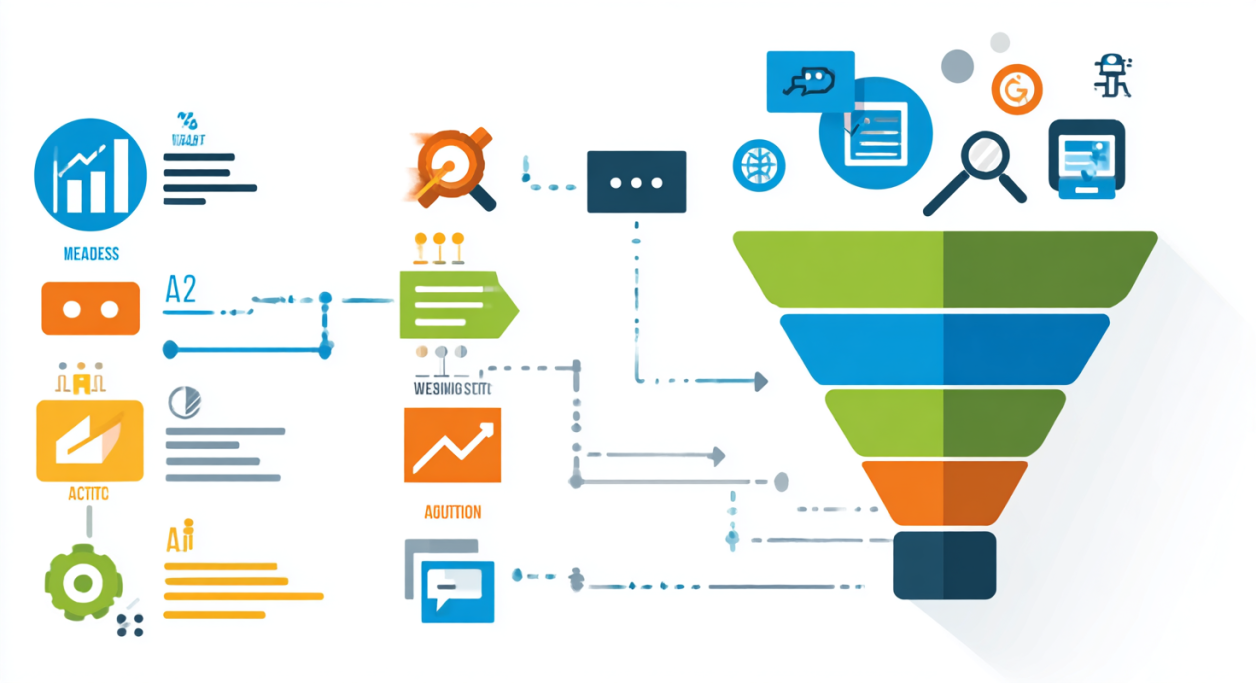Every website attracts traffic. But most of that traffic never converts. Visitors land on your site, browse for a few seconds, and leave without taking action.
That leaves you wondering: how to improve website conversion rate so your traffic translates into real results. After all, you spend time and money bringing people to your site, why let them walk away empty-handed?
This guide is built for beginners who want to understand what conversion rate really means, why it matters for growth, and the exact steps to lift numbers consistently. Think of it as your playbook to turn casual visitors into engaged customers.
Turn visitors into customers - start your CRO playbook
Crack the Conversion Code on Your Website
Before you think about tools, tactics, or optimization tricks, it’s important to start with the basics. You can’t improve what you don’t measure. That’s why the first step in learning how to improve website conversion rate is to understand what conversion really means and why Conversion Rate Optimization (CRO) should be a priority for your business.
Website Conversion Basics
A conversion rate is the percentage of visitors who complete a specific action on your website. This could mean buying a product, requesting a demo, signing up for a newsletter, or even downloading a resource. The exact definition of a conversion depends on your business model and your goals.
For example:
- In e-commerce, a conversion might mean a visitor adds an item to their cart and completes a purchase.
- In SaaS, a conversion could be someone visiting your pricing page and requesting a demo.
Without proper tracking, you’ll never know your baseline numbers. And without that baseline, it’s impossible to identify whether your optimization efforts are moving the needle. That’s why measuring conversions is the foundation of every CRO strategy.
Convin’s AI VoiceBot can help here by engaging visitors on high-intent pages like pricing or checkout, where traditional forms often fail. Instead of letting leads slip away, you capture them in real time.
Importance of CRO
The importance of CRO lies in its ability to maximize the value of every visitor. Rather than spending more on ads or traffic acquisition, you make the most of the visitors you already have. Even small improvements in conversion rate can generate significant revenue growth over time.
Here’s why CRO matters:
- It lowers customer acquisition costs because you get more conversions from the same audience.
- It creates a smoother, more enjoyable user experience, which builds trust and loyalty.
- It helps you earn more revenue per visitor, making your marketing budget more efficient.
- It gives you faster feedback loops, so you know which tactics and messages actually work.
Some website conversion basics for CRO include:
- Running A/B tests to compare different headlines, calls-to-action, or layouts.
- Simplifying forms by removing unnecessary fields that create friction.
- Improving your messaging so visitors immediately understand your value proposition.
- Optimizing page load times and mobile responsiveness, which are often overlooked.
By focusing on these essentials, you create a stronger foundation for growth. Conversion optimization isn’t about one big fix. It’s about continuous small changes that add up to big results.
Set your baseline and fix one friction point today.
Set Clear Goals & Measure Performance
Without clear goals, progress is impossible. This is often the first real step businesses take when learning how to improve website conversion rate. You need to define what success looks like, set measurable targets, and use the right tools to track progress. Numbers, benchmarks, and performance data give you direction, otherwise, you’re just guessing.
What is Conversion Rate in Action
At its simplest, conversion rate is calculated using the formula:
(Number of Conversions ÷ Number of Visitors) × 100%
But this number varies widely depending on your industry and audience.
- E-commerce sites often see conversion rates between 1–3%.
- SaaS businesses may see higher or lower, depending on pricing, complexity, and target audience.
The key is to segment your data so you don’t just rely on one average number. Break down performance by:
- Traffic source (organic, paid, referral)
- Device type (desktop, mobile, tablet)
- Landing page performance
Use Secondary Metrics (Bounce, Time on Page, Exit Rate)
While conversion rate is the main metric, it doesn’t tell the whole story. Secondary metrics show where the funnel is leaking and what’s driving engagement.
- Bounce rate: High bounce = your landing page fails to match user intent.
- Exit rate: Highlights which pages people abandon most often.
- Time on page: Longer stays often signal higher engagement and intent.
- Micro-conversions: Newsletter signups, free trial activations, or resource downloads warm up leads for future conversions.
By tracking these supporting metrics, you create a deeper understanding of visitor behavior and spot areas for improvement.
Tie into Convin Tools and Prior Work
Once your goals and metrics are defined, the next step is to use tools that help you capture and act on visitor intent in real time.
- Convin’s Voicebot Software allows you to engage visitors when they linger on high-intent pages like pricing or product pages.
- For diagnosing leaks, check Boost Website Conversions: Identify and Fix Bottlenecks, which dives into analyzing drop-off points.
By combining analytics with proactive tools, you not only track what’s happening but also actively improve results as they occur.
Define goals today and improve conversions with Convin.
This blog is just the start.
Unlock the power of Convin’s AI with a live demo.

Audit Your Website Experience
If you want to learn how to improve website conversion rate, you first need to understand where visitors get stuck. Most conversion issues aren’t about traffic, they’re about user experience. Poor design, confusing navigation, or technical slowdowns silently push people away. That’s why auditing your website is a crucial step before making any major changes.
Common Conversion Barriers
Many websites unintentionally create friction that stops visitors from taking action. Some of the most common issues include:
- Long or confusing forms that demand too much information
- Slow-loading pages that test user patience
- Poor mobile responsiveness, making it hard to browse on smaller screens
- Weak or unclear calls-to-action that don’t tell visitors what to do
- Lack of trust signals such as reviews, testimonials, or security badges
Bottleneck Analysis
Beyond surface-level issues, it’s important to see where in the funnel users are dropping off.
- Track the visitor journey: landing page → product page → checkout/cart.
- Use heatmaps and session recordings to see where users hesitate or abandon.
- Explore Convin’s blog Boost Website Conversions: Identify and Fix Bottlenecks for proven methods to spot problem areas.
Speed & Mobile Priorities
Speed is one of the most overlooked yet impactful factors in CRO. Even a one-second delay can cost you conversions. Mobile is equally important, as it now accounts for more than half of web traffic in most industries.
- Use tools like Google Lighthouse or PageSpeed Insights to benchmark site speed.
- Compress large images and remove unnecessary scripts.
- Optimize mobile layouts so they load quickly and display clearly.
Audit your site today and remove one barrier.
Improve Messaging, UX & Engagement
This is where the real transformation begins. If you want to know how to improve website conversion rate, your website must align with visitor intent at every step. Clear messaging, frictionless user experiences, and engaging interactions build the trust that turns browsers into buyers.
Clarity in Value Proposition & Messaging
Your messaging is the first impression, and it needs to instantly communicate value. Visitors decide within seconds whether to stay or leave, so your content should remove confusion and highlight why they should choose you.
Key principles to follow:
- Make sure your headline matches the source that brought the visitor (ads, SEO, referrals).
- Highlight benefits instead of just listing features.
- Cut out jargon so visitors instantly understand your offer.
Simplify Navigation & Reduce Friction
Complex journeys discourage users. Every extra click is an opportunity for someone to abandon your funnel. That’s why simplifying navigation is a proven CRO tactic.
Best practices include:
- Reducing the number of clicks needed to reach checkout or signup
- Removing unnecessary fields from forms
- Adding progress indicators to show users how close they are to completion
Use Voicebots & Interactive Elements
Sometimes, visitors hesitate because they have questions or doubts that aren’t answered on the page. This is where interactive support can make a huge difference.
- Convin’s AI VoiceBot triggers automatically when visitors linger on high-intent pages like pricing or features.
- Instead of forcing users to fill out a form, you let them talk instead of type.
- Interactive voice Q&A reduces drop-offs by providing instant, contextual answers.
Update messaging and engage visitors instantly.
Test, Measure & Optimize Continuously
Improvement doesn’t stop after a single fix. The most successful companies know that how to improve website conversion rate is an ongoing process of testing, learning, and iterating. Small, steady improvements add up to big wins over time, making continuous optimization the engine of sustainable growth.
A/B Tests & Experiments
A/B testing is one of the most powerful tools in CRO. It allows you to compare two versions of a page or element and see which performs better.
Best practices include:
- Testing headlines, CTAs, colors, or layouts to see what resonates
- Changing only one element at a time to keep results accurate
- Using statistically significant sample sizes before making decisions
Use Behavior Analytics
Numbers alone can’t tell you everything. To truly understand why visitors act (or don’t), you need to study their behavior.
Behavior analytics tools such as heatmaps, session replays, and scroll maps reveal exactly where users hesitate, click, or abandon.
- Heatmaps show which elements attract attention.
- Session replays let you watch how users navigate.
- Scroll maps highlight where engagement drops off.
For deeper strategies, check Convin’s blog Boost Website Conversions Fast With Simple Fixes, which explains how behavior analytics reduces bounce and improves performance.
Automate Lead Capture & Qualification
Not every visitor who engages is ready to buy, but that doesn’t mean you should lose them. Automating lead capture ensures that potential customers are nurtured even outside business hours.
- Use voicebots to qualify leads instantly while they’re on your site.
- Automate handoffs to your sales team so hot leads aren’t kept waiting.
- Tools like Convin’s Voicebot Software and AI Voice Widgets are designed to engage, qualify, and hand over leads without manual effort.
Test, analyze, and automate to boost conversions.
Moving Forward
You now have a full beginner’s guide on how to improve website conversion rate. By this point, you’ve learned what a conversion rate is, why CRO basics are so important, and how to set clear goals for your website. You’ve also explored practical steps to audit your user experience, simplify navigation, optimize messaging, and engage visitors in real time.
Improving conversions isn’t about one big change. It’s about continuous testing, learning from data, and making small adjustments that compound over time. The more consistently you optimize, the more growth you’ll unlock.
Remember: every visitor is a potential customer, but only if you make their journey simple, clear, and engaging. That’s where tools like Convin’s AI VoiceBot give you an edge, helping you capture leads instantly, answer questions proactively, and reduce drop-offs on high-intent pages.
Get started with Convin’s solution today and turn your traffic into real results.
FAQs
1. What is the conversion rate on a website?
Conversion rate is the percentage of visitors who complete a desired action such as purchases, demo requests, or signups.
2. Why is it important to improve website conversion rate?
Improving conversion rate maximizes the value of your traffic, reduces acquisition costs, and drives more revenue without extra ad spend.
3. What are some website conversion basics?
Basics include tracking key actions, analyzing drop-offs, optimizing CTAs, simplifying forms, and ensuring fast, mobile-friendly pages.
4. How do I know if my conversion rate is good?
It depends on your industry. For example, e-commerce averages 1–3%, while SaaS may be higher or lower depending on product complexity.
5. How can Convin Voicebot help with conversion rate optimization?
Convin’s AI VoiceBot engages visitors on high-intent pages in real time, answers their questions, and captures qualified leads instantly.



.webp)
.webp)
.avif)

.avif)